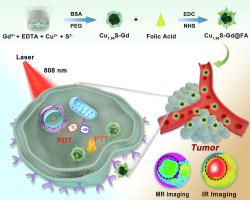Journal of Colloid and Interface Science ( IF 9.9 ) Pub Date : 2022-01-20 , DOI: 10.1016/j.jcis.2022.01.099 Lixin Cheng 1 , Dongmiao Sang 2 , Fangyu Zhao 2 , Lili Yang 3 , Zhilin Guo 2 , Xinfeng Zhang 3 , Qiaoqiao Yang 3 , Wenju Qiao 3 , Xiaohong Sun 3 , Xiaohong Guan 3 , Haoyu Wang 3 , Jiannan Wang 2 , Hongyan Zou 2 , Xiu'e Li 2 , Fang Fang 3 , Yang Li 4 , Shujun Zhang 5 , Lina Wu 3 , Huiming Lin 6 , Xilin Sun 3 , Kai Wang 3

|
Developing new nanoplatforms for dynamically and quantitatively visualizing drug accumulation and targeting within tumors is crucial for precision cancer theranostic. However, achieving efficient tumor therapy via synergistic photothermal/photodynamic therapy (PTT/PDT) using a single excitation light source, remains a challenge. In this work, we designed Gd-surface functionalized copper sulfide nanoparticles that were modified with folic acid (FA) (Cu1.96S-Gd@FA) to overcome the above limitations and promote PTT/PDT therapeutics. Here, Cu1.96S-Gd nanoparticles were synthesized via a coprecipitation method. All samples exhibited high longitudinal relaxivity (up to 12.9 mM−1 s−1) and strong photothermal conversion efficiency (50.6%). Furthermore, the Gd ions promoted electron-hole segregation, inducing the Cu1.96S-Gd nanoparticles to generate more reactive oxygen species (ROS) than pure Cu1.96S nanoparticles. The Cu1.96S-Gd@FA enabled the targeting of folate receptor (FR) and promoted cellular uptake, consequently enhancing oncotherapy efficacy. Compared to non-targeted Cu1.96S-Gd, a higher signal enhancement for magnetic resonance (MR) imaging in vivo by Cu1.96S-Gd@FA was recorded. Given photothermal ability, the nanoparticles also could be visualized in infrared (IR) imaging. Furthermore, the nanoparticles exhibited biodegradation behavior and achieved good drug elimination performance via renal clearance. Our strategy, integrating Cu1.96S-Gd@FA nanoparticles, MR/IR dual-modal imaging, and PTT/PDT into one nanoplatform, demonstrated great potential for anti-breast cancer therapy by effectively targeting FR overexpressed breast cancer cells.
中文翻译:

基于Cu1.96S-Gd@FA的磁共振/红外双模成像引导协同光热/光动力治疗纳米平台用于精准癌症治疗
开发新的纳米平台以动态和定量地可视化药物在肿瘤内的积累和靶向对于精确的癌症治疗至关重要。然而,使用单一激发光源通过协同光热/光动力疗法 (PTT/PDT) 实现有效的肿瘤治疗仍然是一个挑战。在这项工作中,我们设计了用叶酸 (FA) (Cu 1.96 S-Gd@FA) 修饰的 Gd 表面功能化硫化铜纳米粒子,以克服上述限制并促进 PTT/PDT 治疗。在这里,Cu 1.96 S-Gd 纳米粒子通过共沉淀法合成。所有样品都表现出高纵向弛豫率(高达 12.9 mM -1 s -1) 和强大的光热转换效率 (50.6%)。此外,Gd 离子促进了电子-空穴的分离,诱导 Cu 1.96 S-Gd 纳米粒子比纯 Cu 1.96 S 纳米粒子产生更多的活性氧 (ROS) 。Cu 1.96 S-Gd@FA 能够靶向叶酸受体 (FR) 并促进细胞摄取,从而提高肿瘤治疗效果。与非靶向 Cu 1.96 S-Gd 相比, Cu 1.96对体内磁共振 (MR) 成像的信号增强更高记录了 S-Gd@FA。鉴于光热能力,纳米粒子也可以在红外(IR)成像中可视化。此外,纳米颗粒表现出生物降解行为,并通过肾脏清除实现了良好的药物清除性能。我们的策略将 Cu 1.96 S-Gd@FA 纳米颗粒、MR/IR 双模成像和 PTT/PDT 集成到一个纳米平台中,通过有效靶向 FR 过表达的乳腺癌细胞,展示了抗乳腺癌治疗的巨大潜力。



























 京公网安备 11010802027423号
京公网安备 11010802027423号